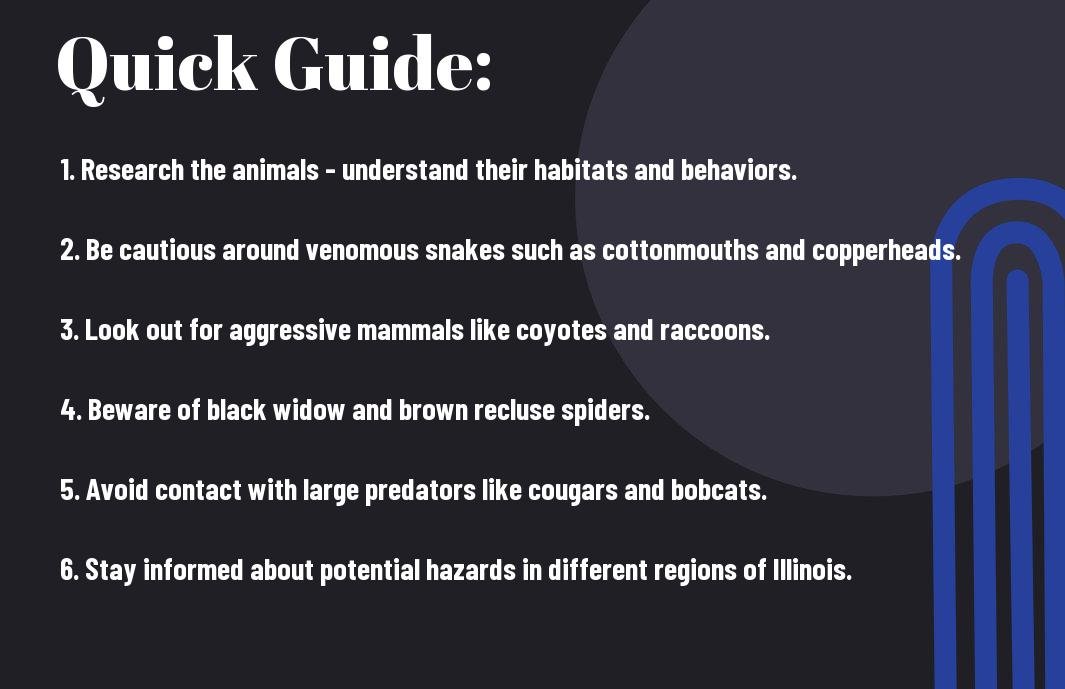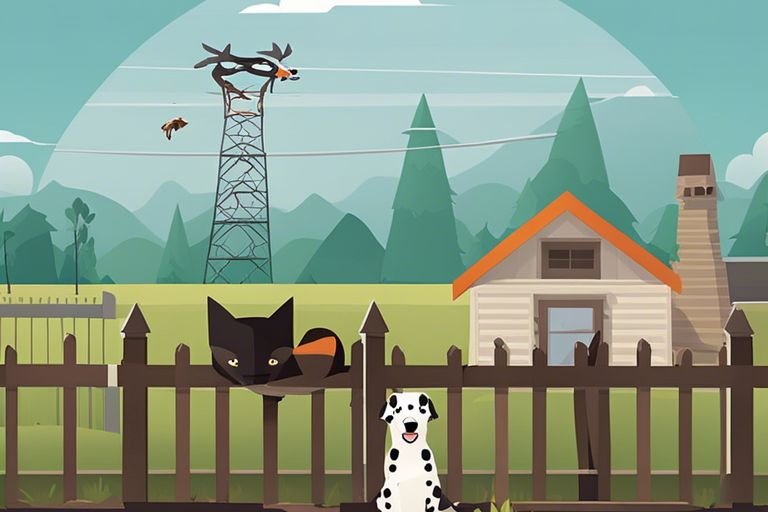As an outdoor enthusiast, I am always eager to explore the diverse wildlife of Illinois. From the towering trees of Shawnee National Forest to the vast prairies of Midewin National Tallgrass Prairie, the state is brimming with natural beauty. However, it’s essential to be aware of potential hazards and dangers lurking amidst the flora and fauna. In this guide, I will walk you through some of the most dangerous animals in Illinois, and provide tips on how to stay safe when encountering them. From venomous snakes to aggressive mammals, knowing how to identify and handle these potential dangers can make all the difference during your outdoor adventures. So grab your gear and let’s delve into the wilderness of Illinois while staying informed and prepared.
Key Takeaways:
- Coyotes are the most dangerous animal in Illinois: Despite common misconceptions, coyotes are responsible for the majority of attacks on humans and pets in Illinois.
- Deer pose a hazard on the roads: With a large population and tendency to cross roads, deer can be a significant danger to motorists in Illinois.
- Ticks are a common threat: Tick-borne illnesses, such as Lyme disease, are a prevalent risk for outdoor enthusiasts in Illinois.
- Snakes can be venomous: Illinois is home to several species of venomous snakes, making it important to be cautious when encountering them in the wild.
- Bee and wasp stings can be deadly: Allergic reactions to stings from bees and wasps can be fatal, making them a significant hazard in Illinois.
Types of Dangerous Animals in Illinois
Before I delve into the specific types of dangerous animals in Illinois, it’s important to note that encounters with wild animals can happen in any part of the state, from urban areas to rural landscapes. Whether you’re out hiking, camping, or simply spending time in your backyard, it’s crucial to be aware of the potential hazards posed by venomous snakes, aggressive insects, and predatory mammals. This knowledge can help you take the necessary precautions to stay safe.
| Venomous Snakes | Aggressive Insects |
| – Eastern Massasauga – Copperhead – Timber Rattlesnake – Cottonmouth |
– Hornets – Yellowjackets – Bees – Wasps |
| Predatory Mammals | |
| – Coyotes – Bobcats – Bears – Mountain Lions |
Venomous Snakes
Illinois is home to several species of venomous snakes, including the Eastern Massasauga, Copperhead, Timber Rattlesnake, and Cottonmouth. While these snakes generally avoid human interaction, accidental encounters can occur, especially in wooded areas, tall grass, and near bodies of water. It’s important to be able to identify these snakes and know how to react if you come across one to avoid potential snakebite incidents.
Aggressive Insects
When it comes to aggressive insects, Illinois is no stranger to species like hornets, yellowjackets, bees, and wasps. While these insects play an essential role in the ecosystem, they can become dangerous when they feel threatened or disturbed. Knowing how to identify their nests and understanding their behavior can help you minimize the risk of insect stings and their potential consequences.
Predatory Mammals
Although encounters with predatory mammals are less common, Illinois is home to coyotes, bobcats, bears, and even the occasional mountain lion. While these animals typically avoid interactions with humans, it’s important to be aware of their presence, especially when venturing into wooded or remote areas. Understanding their behavior and knowing how to respond if you encounter them is essential for staying safe in the great outdoors.
Tips for Identifying Hazards
Some key ways to identify hazards in Illinois include:
- Learning to recognize venomous animals such as snakes and insects
- Being aware of predatory mammals in the area
- Knowing how to identify dangerous plants such as poison ivy
Though the prairie state may seem picturesque, it’s important to be aware of potential hazards in order to stay safe while exploring nature.
Recognizing Venomous Snakes
Illinois is home to several species of venomous snakes, including the Eastern Massasauga Rattlesnake and the Copperhead. These snakes can be identified by their distinct markings and are typically found in wooded areas, so be sure to watch your step.
Avoiding Confrontations with Predatory Mammals
While Illinois is primarily known for its white-tailed deer and coyotes, there are also predatory mammals such as bobcats and cougars that inhabit the state. If you encounter one of these animals, it’s important to remain calm and slowly back away to avoid any potential confrontations.
Protection from Aggressive Insects
Illinois is also home to a variety of aggressive insects such as bees, wasps, and hornets. To protect yourself from their painful stings, be sure to wear appropriate clothing and use insect repellent when spending time outdoors.
Step-by-Step Guide to Staying Safe
Keep yourself safe by following these tips for avoiding encounters with dangerous animals in Illinois:
| Avoidance | Keep a safe distance from wildlife, do not approach or feed them |
| Stay on Trails | Avoid straying off designated paths, this helps reduce the risk of encounters |
| Notify Others | Inform someone of your hiking or camping plans, including your estimated return time |
| Use Caution at Night | Be extra cautious during dawn and dusk when animals are most active |
Precautions While Hiking or Camping
When hiking or camping in Illinois, it is important to take certain precautions to avoid encounters with dangerous animals. Always make loud noises while hiking to give animals a chance to flee, and keep food and trash properly stored to avoid attracting wildlife to your campsite. Additionally, carry bear spray or pepper spray for self-defense in case of animal encounters.
Dealing with Wildlife Encounters
If you encounter wildlife, remember to stay calm and try to appear larger by waving your arms. Do not run or turn your back on the animal. Back away slowly while facing the animal and make loud noises to scare it off. Remember, it is important to give wildlife the space they need to feel safe and unthreatened.
First Aid for Animal Attacks
In the event of an animal attack, it is crucial to seek medical attention as soon as possible. If bitten, try to wash the wound thoroughly with soap and water, and seek professional medical treatment to prevent any potential diseases or infections. Even if the injury seems minor, it is always best to have it checked by a healthcare professional to ensure your safety.
Factors to Consider for Avoiding Danger
After identifying the most dangerous animals in Illinois, it’s important to understand the factors that contribute to potential danger in encounters with wildlife. By considering these factors, I can better prepare yourself for navigating the natural environment and avoiding potential hazards. The following are key considerations:
- Animal behavior and body language
- Environmental risk factors
- Human-wildlife conflict
Any encounter with wildlife requires your awareness and caution.
Understanding Animal Behavior
Understanding animal behavior is crucial when it comes to avoiding potential danger. By being mindful of animal behavior and body language, you can better assess the situation and take appropriate action to avoid conflict. This can include observing signs of aggression, distress, or predatory behavior in wildlife encounters.
Environmental Risk Factors
When exploring the habitats of Illinois, it’s important to be aware of the environmental risk factors that can contribute to dangerous encounters with wildlife. This can include factors such as terrain, visibility, and proximity to potential animal habitats. Perceiving and understanding these risk factors can help you navigate the environment more safely and responsibly.
Human-Wildlife Conflict
Human-wildlife conflict can arise in various situations, from urban areas to natural habitats. It’s important to recognize the potential for conflict and take steps to minimize risks. Whether it’s encountering animals while hiking, camping, or even in residential areas, being aware of your surroundings and taking precautions can help prevent dangerous situations.
Pros and Cons of Wildlife Interaction
Unlike domestic animals, wildlife interaction can provide a thrilling and educational experience. However, it also comes with its fair share of dangers. Below, I break down the pros and cons of wildlife interaction in Illinois:
| Pros | Cons |
| Opportunity to observe animals in their natural habitat | Potential risk of animal attacks |
| Increased awareness and appreciation for wildlife | Possible spread of diseases from animals to humans |
| Learning about local ecosystems and habitats | Environmental impact due to interference with animal behavior |
| Contribution to conservation efforts through citizen science | Legal consequences for disturbing or harming wildlife |
| Opportunity for recreational activities such as birdwatching and photography | Challenges in ensuring safety, especially with children |
Benefits of Biodiversity
One of the most significant advantages of wildlife interaction is the exposure to biodiversity. By engaging with diverse animal and plant species, you can gain a deeper understanding of the interconnectedness of ecosystems. This can lead to a greater appreciation for the delicate balance of nature and the importance of conservation efforts. Additionally, witnessing the beauty and uniqueness of different species can inspire a sense of wonder and awe, fostering a desire to protect and preserve the natural world.
Downsides of Encounters with Dangerous Animals
While wildlife interaction can be an enriching and eye-opening experience, it’s essential to recognize the potential downsides, particularly when dealing with dangerous animals. Encounters with venomous snakes, aggressive mammals, or territorial birds can pose serious risks to your safety. In some cases, these encounters may result in injury or even fatalities. Additionally, the psychological impact of a terrifying encounter with a dangerous animal can have lasting effects, leading to fear or anxiety in future wildlife interactions.

Most Dangerous Animal in Illinois – Identifying Hazards in the Prairie State
Now that we have identified the most dangerous animals in Illinois, it is important to be aware of these potential hazards when spending time outdoors in the state. Whether you are camping, hiking, or simply enjoying nature, it is crucial to be mindful of your surroundings and take precautionary measures to avoid encounters with these animals. By educating yourself on the potential dangers and knowing how to react in case of an encounter, you can better protect yourself and others from harm. Stay informed, stay cautious, and enjoy the beauty of Illinois while being aware of potential wildlife hazards.
FAQ
Q: What is the most dangerous animal in Illinois?
A: The most dangerous animal in Illinois is the tick. Ticks carry a variety of diseases, including Lyme disease and Rocky Mountain spotted fever, which can be harmful to humans and pets.
Q: How can I identify a tick?
A: Ticks are small, arachnid creatures that can range in color from brown to reddish-brown. They have eight legs and can be found in wooded and grassy areas, as well as on pets and humans.
Q: Are there venomous snakes in Illinois?
A: Yes, Illinois is home to several species of venomous snakes, including the copperhead and the timber rattlesnake. It’s important to be cautious when hiking or spending time outdoors in areas where these snakes are known to inhabit.
Q: What should I do if I encounter a venomous snake?
A: If you encounter a venomous snake in Illinois, it’s important to remain calm and slowly back away from the snake. Do not attempt to handle or provoke the snake in any way. Seek immediate medical attention if bitten by a venomous snake.
Q: Are there any other dangerous animals in Illinois?
A: While ticks and venomous snakes are the most notable hazards in Illinois, it’s also important to be cautious around wild animals such as raccoons and skunks, which can carry rabies. Additionally, stinging insects like bees and wasps can pose a threat to those with allergies. It’s important to be aware of your surroundings and take necessary precautions when encountering wildlife in Illinois.











